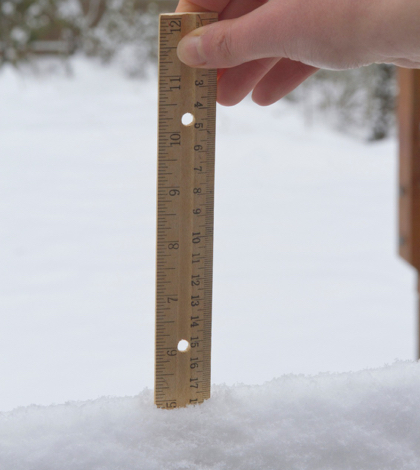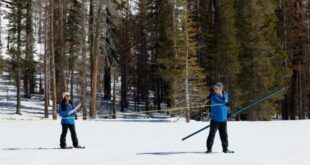The second snow survey of Water Year (WY) 2017-18 was conducted Monday at Phillips Station by Frank Gehrke, chief of the California Cooperative Snow Surveys Program, and the results paint an improving – but by no means secure – picture for precipitation-needy California. Although the recent late-winter storm that brought much-needed snow to the Sierra Nevada, the snow water equivalent (SWE) was measured at 9.4 inches or just 39 percent of normal for early March. The initial snow survey for February done last Wednesday – the official snow survey of record — at Phillips Station produced a dismal SWE of just 1.7 inches or seven percent of the February long-term average.
“As indicated by the increase in snow depth and water content from last week to today, this recent storm provided a much-needed boost to our snowpack,” said Gehrke. “Today’s measurements are greater than what we found last week, but not enough to bring the state up to an average year.”
SWE is the amount of water contained within the snowpack. The snowpack – often called California’s “frozen reservoir “– normally provides about a third of the water for California’s farms and communities as it melts in the spring and summer filling reservoirs and rivers.
California’s Department of Water Resources (DWR) logs both electronic and manual SWE readings throughout the winter and spring months in order to gauge water availability for lakes and reservoirs and ultimately for use by farmers and urban uses. Phillips Station, near Lake Tahoe, is one of 260 manual survey sites conducted throughout the winter. Electronic readings are collected from 103 stations spread across the Sierra Nevada.
Current electronic measurements indicate the SWE of the northern Sierra snowpack is 7.4 inches, 30 percent of the multi-decade average for Monday. The central and southern Sierra readings are 11.5 inches (43 percent of average) and 8.7 inches (37 percent of average), respectively. Statewide, the snowpack’s SWE is 9.5 inches, or 37 percent of the March 5 average. With the predicted intensity of the most recent storms, Gehrke conducted a second measurement on March 5 to record its impact, which yielded a 32 percentage-point increase in SWE over the previous week at Phillips Station.
DWR Director Karla Nemeth summed the most recent measurements saying, “California has unquestionably experienced a dry winter this year, with a near-record dry February. While we’re happy to kick off March with this healthy storm, the variability of this winter’s weather patterns underscores the importance of continued conservation and the ongoing need to strengthen California’s water supply reliability for our people, our economy, and our environment.”
 California Water News Daily Your Source For Water News in California
California Water News Daily Your Source For Water News in California


